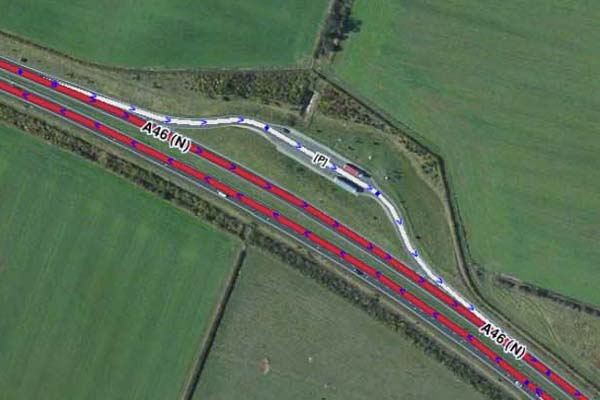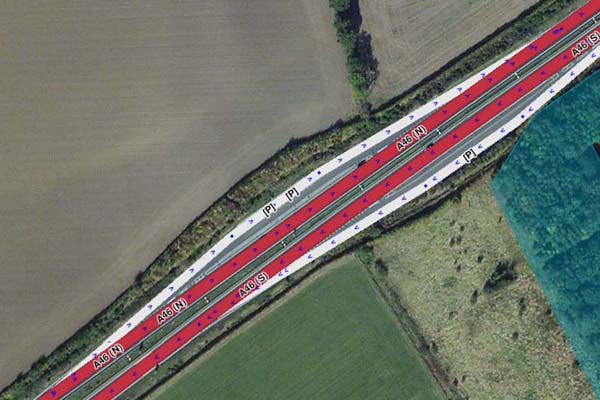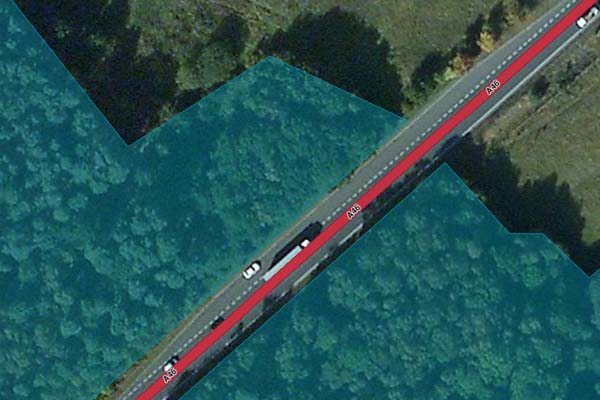This page covers road names for the United Kingdom. For other countries see here.
Introduction
This forms part of UK Editing Best Practice. Editors are encouraged to follow these guidelines.
Abbreviations
The following abbreviations should be used where possible to conserve screen space.
| Road Name | Abbreviation | TTS Expansion? |
|---|---|---|
| Avenue | Ave | Yes |
| Boulevard | Blvd | Yes |
| Broadway | Bdwy | Untested |
| Circus | Cir | Untested |
| Close | Cl | Yes |
| Court | Ct | Yes |
| Crescent | Cr | Yes |
| Drive | Dr | Yes |
| Garden | Gdn | Untested |
| Gardens | Gdns | Yes |
| Green | Gn | Untested |
| Grove | Gr | Untested |
| Junction (as in Motorway Jxx) | J | Yes |
| Lane | Ln | Yes |
| Mount | Mt | Untested |
| Place | Pl | Yes |
| Park | Pk | Untested |
| Ridge | Rdg | Untested |
| Road | Rd | Yes |
| Saint | St. | Yes |
| Square | Sq | Untested |
| Street | St | Yes |
| Terrace | Ter | Yes |
| Valley | Val | Untested |
Notes:
- Roads like "The Avenue", "The Green" etc should not normally be abbreviated.
- TTS = Text To Speech
Road types
The following convention should be followed where possible, although it is acknowledged that you may need to deviate from it in some circumstances.
| Waze Road Type | UK Road Types |
|---|---|
| Freeway | Motorway |
| Major Highway | Trunk roads (other than motorways) as defined below. |
| Minor Highway | Non-trunk A-class roads or dual-carriageway B-class |
| Primary Street | Other B-class roads and roads carrying heavier traffic. |
| Streets | Urban Streets, Low traffic rural roads |
For Freeways leave the City Name as "None", so as to stop the City Names smearing.
Trunk Road Maps
- Scottish Trunk Roads (Traffic Scotland)
- English Trunk Roads (Highways Agency) | London Trunk Roads (Transport for London)
Dual Carriageways
The following convention should be followed where possible, although it is acknowledged that you may need to deviate from it in some circumstances.
When to Split
A road should be split into be 2 one-way roads if any of the following conditions are met:
- The central reservation is > 5m
- There's a visible gap between average of all GPS traces
- It is split by physical barrier (Concrete, Armco, pedestrian barrier etc)
Pedestrian refuges and painted road separation (cross hatching that can be driven over) should not normally be split. Be aware there are a lot of these that were created as split roads during the UK Base-map import, these usually need merging to be a single two-way road.
Naming Convention
Whenever possible, on split roads, name carriageways with the direction of travel. Insert the direction of travel at the end of the road name:
Examples: 1. M1 (N) 2. A4 (W) 3. M25 (ACW)
This makes traffic and incident reports much more useful and helps with navigation.
Ramps (to/from Motorways and Dual Carriageways)
Where should I start the sliproad?
For best navigation and routing advice, sliproads leading:
off a Motorway or Dual Carriageway should be placed to start where
- The lane begins to divide (in the case of 3/2/1 markers)
- There is a gantry over the carriageway, where the 1 mile, 1/2 mile etc finishes. This will usually be the last gantry before the actual junction and will be the one without a distance marker on it
on to a Motorway or Dual Carriageway should be placed where
- the road first joins the adjoining road, i.e. just after the chevrons/lane dividers
Naming Ramps
For the best balance between information, routing, reports and screen real estate the following convention should be used for sliproads (ramps):
Exit Ramps:
<Road Number> (<Direction>) (<Junction Number>) Exit (<” to ” Road Number 1, Road 2 …>)
Examples: 1. M54 (E) J4 Exit to A464 2. A46 (N) Exit to A6 3. M1 (S) J24 Exit to A453, A6 4. M1 (N) J24 Exit to A453 5. M4 (W) J4B Exit to M25 6. M5 (N) Exit to Services
Entry Ramps:
“Entry to” <Road Number> (<Direction>) (<Junction Number>)
Examples: 1. Entry to M54 (E) J4 2. Entry to A46 (N) 3. Entry to M1 (S) J24 4. Entry to M1 (N) J24 5. Entry to M25 (N) J15 6. Entry to M5 (N)
Notes:
- Fields marked in parenthesis (<field>) are optional.
- Onward roads should only added if they are shown on road signage as this is an aide to the driver to confirm they have the correct exit (e.g. Exit ramp example 4 which also has A6 and A50 not on signage). [Hint: look on streetview]
- Roads with clockwise or anticlockwise directions (e.g. M25) should have have ramp directions taken from signage which will typically be N, S, E or W (e.g. Entry ramp example 5). [Hint: look on streetview]
- Both example 6's above refer to Motorway Service Area (MSA) entry/exit ramps that do not have a junction number, where an MSA is integrated into a standard junction normal ramp naming applies.
- Please set the City Name to "None". (ie Put a tick in the box, don't actually name it "None"). This should help with City smudges.
Junction Naming
Major junctions, particularly on motorways, should be labelled with a landmark.
Under no circumstances should the road name or city name fields of a segment be used for naming of a junction.
Detailed information and examples have been moved to the Landmarks Wiki Page
Road Name & Number
Where a road exhibits both a road number and name the following convention should be used:
<Number> - <Name>
Examples: 1. A7 - Old Dalkeith Rd 2. A1 - Edinburgh Rd
This gives both a consistent appearance and allows a straightforward transfer if/when Waze UK moves to the official Department for Transport designations.
The same can also be said for adding the direction of travel on single/dual carriageways with an A-road designation in the form
<Number> (Direction) - <Name>
Examples: 1. A2 (W) - Dover Rd 2. A229 (N) - Cuxton Rd
Roundabouts
To aid navigation instructions, roundabout segments should typically remain unnamed. If the roundabout does have a proper, signposted name, then this can be labelled using a landmark of "Junction/Intersection" type that fills the centre of the roundabout. This only applies to big roundabouts that are larger than 30 metres.
Detailed information and examples have been moved to the Landmarks Wiki Page
For further advice on editing roundabouts, see Editing Junctions and Roundabouts
Motorway Service Areas
Information on mapping Motorway Service Areas is now on the Landmarks Wiki Page
Lay-bys
- Lay-bys should only be included where there is significant separation from the main road (e.g. grass, trees or a physical barrier) in a similar way to deciding if a road is dual carriageway.
- Routes in and out should be mapped with roads of "Parking Lot Road" type, with appropriate directions and turns.
- The Lay-by road should have no city name and the road name set to "[P]".
- A Landmark is not required for lay-bys.
Lay-by Examples:
This example shows significant separation between the road and Lay-by:

This example is only separated by the distance between the (N) and (S) carriageways which is the minimum that you should map. Note that the "parking lot road" is mapped over the area that vehicles park on to improve separation:

This example does not have enough separation for the Lay-by to be mapped:

(Note: this example is zoomed in closer that the previous two!)
Bypass or By-pass?
Bypass.